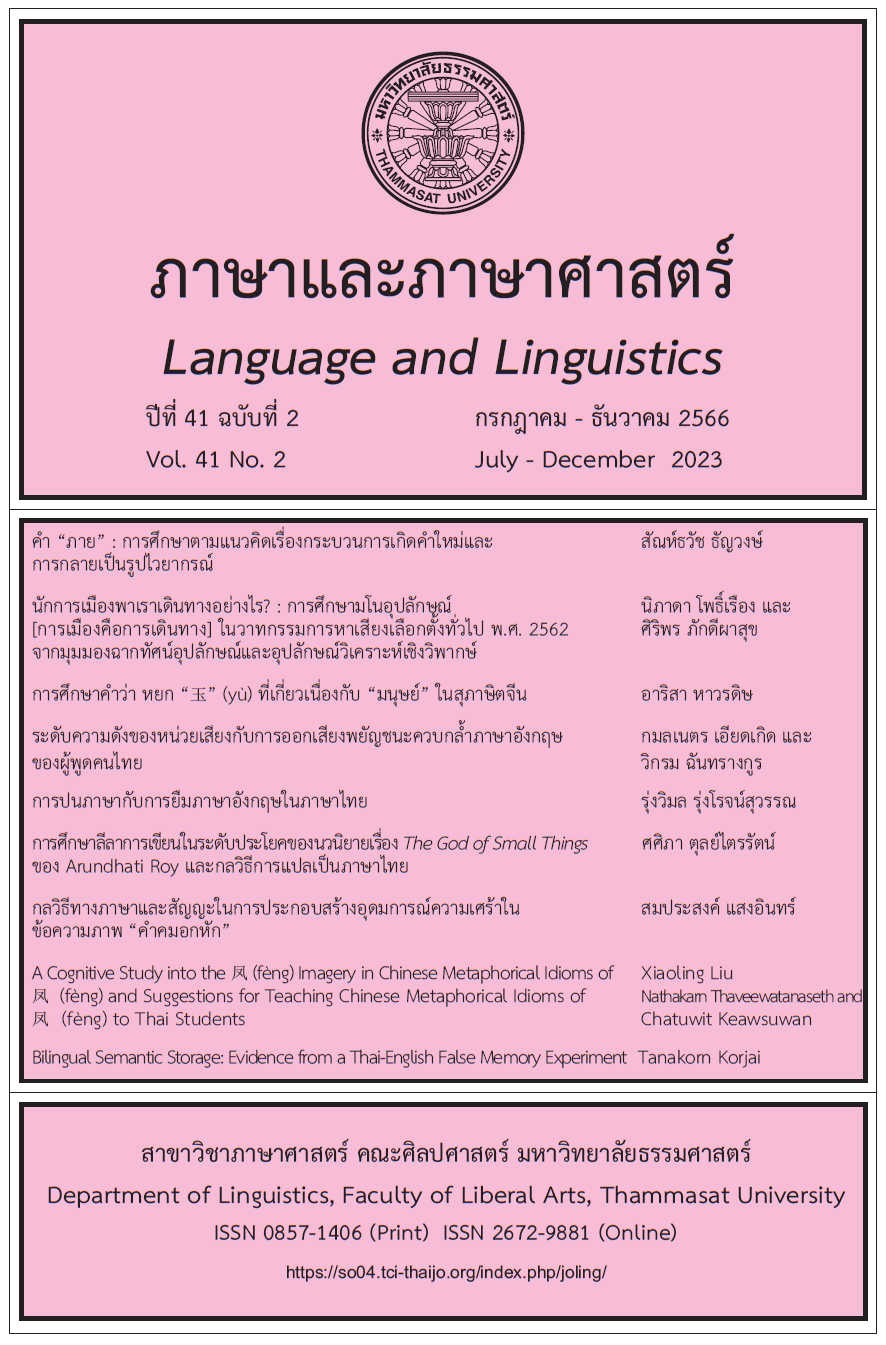A Cognitive Study into the 凤(fèng) Imagery in Chinese Metaphorical Idioms of 凤(fèng) and Suggestions for Teaching Chinese Metaphorical Idioms of 凤(fèng) to Thai Students
Main Article Content
Abstract
The study analyzed the 凤 (fèng, Chinese phoenix) imagery in 182 Chinese metaphorical idioms of 凤 (fèng) from the Chinese Idiom Dictionary (《中华成语大词典》) from a cognitive linguistic perspective. The study aimed to explore the semantic meaning of these idioms and propose teaching methods to help Thai students avoid errors in understanding their semantic meaning. The study found that the Chinese metaphorical idioms of 凤 (fèng) use the 凤 (fèng) as the source domain to map onto humans or things (target domain) and create eight categories of 凤 (fèng) imagey. Furthermore, there are 18 other types of animal imagery created by 18 other types of animal metaphors in these idioms, such as the imagery of 龙 (lóng, Chinese dragon), 鸡 (jī, chicken) and so forth, which are equivalent to or suppressed by the 凤 (fèng) imagery. The study also found that understanding the semantic meaning of these idioms can be based on understanding the 凤 (fèng) imagery in these idioms. Based on the study’s findings, we suggest that teachers use the imagery teaching method to avoid Thai students’ errors in understanding the semantic meaning when teaching Chinese metaphorical idioms of 凤 (fèng) to Thai students. By adopting these teaching methods, teachers can integrate the cognitive analysis of the 凤 (fèng) imagery into their teaching.
Article Details

This work is licensed under a Creative Commons Attribution-NonCommercial-NoDerivatives 4.0 International License.
บทความทุกบทความเป็นลิขสิทธิ์ของภาษาและภาษาศาสตร์
References
Ellis, R. (1994). The study of second language acquisition. Oxford University Press.
Gibbs, R. W., & O’Brien, J. E. (1990). Idioms and mental imagery: The metaphorical motivation for idiomatic meaning. Cognition, 36, 35-68.
Krashen, S. (1985). The Input hypothesis: Issues and implications. Longman.
Krungkaeo, W. (2022). Creating performing arts based on Swan local arts, auspicious animals according to Chinese symbol beliefs in Phuket. Parichart Journal Thaksin University, 35(2), 165-184.
Lakoff, G., & Johnson, M. (1980). Metaphors we live by. University of Chicago Press.
Lakoff, G., & Turner, M. (1989). More than cool reason: A field guide to poetic metaphor. The University of Chicago Press.
Littlemore, J. (2003). The effect of culture background on metaphor interpretation. Metaphor and Symbol, 18(4), 231-238.
Richards, A. (1965). The Philosophy of Rhetoric. Cambridge University Press.
Shieh, C. C., Liu, Q., & Pan, X. (2017). Error analysis and recommendations of teaching on Thai students learning Chinese idioms. Graduate School Journal Chiang Rai Rajabhat University, 10(3), 1-10.
Ungerer, F., & Schmid, H. J. (1996). An introduction to cognitive linguistics. Longman.
CASS Institute of Linguistics Dictionary中国社会科学院语言研究所词典编辑室. (2016). 现代汉语词典 (第7版). 商务印书馆.
Chen Cheng陈成. (2016). 山海经译注. 上海古籍出版社.
Cui Yingying崔莺莺. (2017). 汉日马文化意象对比研究再探——以成语、谚语为分析对象. 佳木斯职业学院学报, (03), 75.
Duan Hongmei段红梅. (2020). 高中语文古诗词意象教学的四个路径. 教学与管理, (22), 55-56.
Jiang Chengsheng, & Liang Jinxiang蒋澄生、梁锦祥. (2007). 试论成语中的意象表征. 外语学刊, (04), 52-54.
Lian Shuneng连淑能. (2002). 论中西思维方式. 外语与外语教学, (02), 40-46, 63-64.
Luo Xiaochun罗晓春. (2012). 成语中的 “柳” 意象. 鸡西大学学报, (04), 111-112.
Pang Jin 庞进. (2007). 中国凤文化. 重庆出版社.
Qu Yuan屈原. (2019). 楚辞. 吴广平导读注译. 岳麓书社.
Qiu Yubing邱玉冰. (2002). 汉语 “四灵” 文化与英语龙凤龟之比较. 广西民族学院学报 (哲学社会科学版), (01), 78-80.
Shi Lin石琳. (2014). 留学生汉语成语偏误成因分析. 北京化工大学学报 (社会科学版), (02), 61-65.
Wang Wenbin, & Yao Jun王文斌、姚俊. (2004). 汉英隐喻习语ICM和CB的认知对比考察--以汉语的四字格隐喻习语为基点. 外语与外语教学, (05), 36-40.
Wang Xiaojun, & Xu Jing王晓俊、许菁. (2020). 英汉数字习语的原型意象阐释. 河南工程学院学报 (社会科学版), (04), 60-66.
Wang Yin王寅. (2007). 认知语言学. 上海外语教育出版社.
Wang Zhimin王治敏. (2019). 十二生肖成语搭配与隐喻认知分析. 国际汉语教育 (中英文), 4(03), 41-50.
Wei Shishui韦氏水. (2018). 文化与对外汉语词汇教学——以教越南学生学习汉语动物成语为例. 海外华文教育, (02), 98-104.
Wen Xiaohong温晓虹. (2012). 汉语作为第二语言的习得与教学. 北京大学出版社.
Yang Tianyu杨天宇. (2004). 礼记译注. 上海古籍出版社.
Yu Jingyang, & Piao Meihui于婧阳、朴美慧. (2015). 动物成语隐喻认知研究[J]. 沈阳师范大学学报 (社会科学版), 39(04), 109-111.
Zhang Hui张辉. (2003). 熟语及其理解的认知语言学研究. 军事谊文出出版社.
Zhang Jie张杰. (2010). 试论汉语对中国传统思维方式的建构. 社会科学战线, (07), 129-143.
Zhao Yanfang 赵艳芳. (2001). 认知语言学概论. 上海外语教育出版社.
Zheng Weili, & Zhou Qian 郑微莉、周谦. (2019). 中华成语大词典. 商务印书 馆国际有限公司.
Zhou Guangqing周光庆. (1994). 成语内部形式论. 华中师范大学学报 (哲学社会科学版), (05), 112-117.
Zhou Guangqing周光庆. (1995). 成语中介符号论. 语言文字应用, (01), 91-96.
Zhu Quanguo朱全国. (2007). 隐喻与意象. 求索, (10), 186-188.

